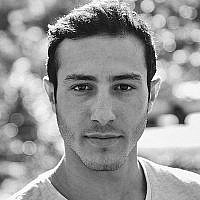
As I mentioned in the introduction, before I was in Krav Maga, I started out as an athlete. Before I was a year old, I was already running, and by the age of thirteen, I was studying capoeira and playing soccer. I may have been smaller than the other kids, but I was fast and agile, making me a strong player.
One day, my older brother Gal invited me to come to his Krav Maga gym with him. I had nothing else to do and wanted to get out of the house. Doing some flips and inversions on the mats, and hit some heavy bags sounded like fun.
It wasn’t fun. It was life-changing. Krav Maga was nothing like capoeira and soccer. It had no rules, and was real life. It wasn’t about having fun, it was about surviving real threats. I wanted to know more.
The Real World Hits Hard
The price of that knowledge was blood, sweat and tears. Literally. My shirts quickly got stained from sweat, bloody and gross from the nosebleeds from sparring and the puking during warm-ups, and tears from the frustration. While here in New York City, kids coming home with repeated nosebleeds and puking would have caused lawsuits, back in Israel, we’re told that getting hit was a part of sparring. There was no time for being coddled.
The training was realistic and tough. That isn’t to say safety wasn’t at the highest level. My master, Gabi Noah, is one of the original students of Grandmaster Imi. He remains one of the most highly regarded instructors in the world. Gabi was not only an experienced civilian instructor, but had trained special forces, law enforcement, military and counter-terror teams. As a lot of money is invested into those picked for such duties, he was an expert at balancing safety with realism. He could creative and safely put pressure into all aspects of training.
I remember one time him telling the students to grab jump ropes and begin jumping, he’d be right back.
We started jumping.
A minute passed and Gabi was still not back.
Then two minutes passed and we were starting to get winded.
Five minutes and we were really starting to feel the burn, but no one dared stop. No one wanted to be the quitter.
Ten minutes of jumping rope and we were dripping with sweat and miserable.
Gabi leisurely strolled in, carrying a bag of fruit. “I went to the store, I bought a peach and a nectarine and some grapes…” he said with a content smile as we all collapsed in exhaustion.
Standing Strong
There was a method to this madness. We learned we could not give up, no matter the challenge.
Gabi taught us that when there is a threat, we have to protect ourselves and our loved ones. It didn’t matter how hard it was. One of the expressions I still take with me to my own students is “it’s fine to cry, as long as you keep fighting.” We could not be afraid, we had to respond with full force required in order to neutralize the threat. Our opponent was going to be bigger and stronger than us, and we had to train hard to survive in this stressful and scary moment.
He didn’t have to convince me. I was the smallest in the group, both in the beginning when I trained with the teenagers, and even more so when I was allowed to take the adult classes. This was highlighted even more in tournaments. (The issue of Krav Maga tournaments is a long one and I’ve outlined an article on it. At that time, Israel held them)
At first tournament, I was the smallest in my weight class. I won the first match but I got demolished in the second match. Even through the gear, my opponent’s strikes were so hard, they made me see stars. I got knocked down, and even though I was able to get to my feet, my opponent won the match.
On the ride home, I realized size mattered. I couldn’t change my height, so I had to be better technically than my opponents and courageous enough to fight even though the odds were against me.
I practiced every technique over and over so that every aspect was clean and correct. Gabi and Gal trained me on how to use speed, aggression, tactics and skills. There was no point in fighting power against power, but I could fight technique vs power. If I couldn’t change my height, I could change my attitude and outwork my opponents. I would practice longer and harder than any other student. Even if I puked in a lot of classes from pushing myself so hard, I also made progress.
Anything less than my best wasn’t an option.
This attitude was not theoretical or limited to tournaments. When I began my Krav Maga journey at thirteen, I was well aware of what awaited me in five years. When I trained, I trained not only to get better, but that one day, when I was called to serve, I would be able to defend myself and my loved ones. That journey began at sixteen and a half when I got my first draft notice.
- Tehran fails to impress on Krav Maga - September 18, 2023
- The Pursuit of Perfection - August 7, 2023
- Grace Under Pressure - March 17, 2023

Leave a Reply